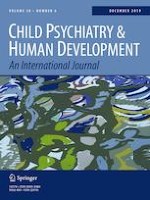07-05-2019 | Original Article
The Multidimensional Youth Body Dysmorphic Inventory: Development and Preliminary Validation
Gepubliceerd in: Child Psychiatry & Human Development | Uitgave 6/2019
Log in om toegang te krijgenAbstract
A new measure specifically designed for adolescents to assess body dysmorphic disorder (BDD) symptoms is needed to identify youth who could benefit from intervention to reduce their BDD-related symptomology. To address this gap, the Multidimensional Youth Body Dysmorphic Inventory (MY BODI) was developed and the psychometric properties were evaluated. Following development and expert assessment, Australian secondary school students (N = 582; 55% female; Mage = 13.62, SD = 1.59, aged 11 to 18 years, grades 7 to 12) completed a survey with the new items and validation measures. Results from the factor analysis supported a 3-factor, 21-items measure, which aligned with the DSM-5 diagnostic criteria of Impairment/avoidance, Preoccupation/repetitive behaviours, and Insight/distress. Supporting the convergent validity of the measure, the MY BODI total score and sub-scale scores correlated with measures of BDD symptoms, including the Appearance Anxiety Inventory (AAI) and Body Dysmorphic Disorder Questionnaire-Adolescent Version (BDDQ-A). This study provides preliminary validation of the MY BODI, a self-report measure of BDD symptoms and symptom severity, using a response set aimed to facilitate more reliable reporting, which may identify risk for BDD, and symptoms of BDD.
